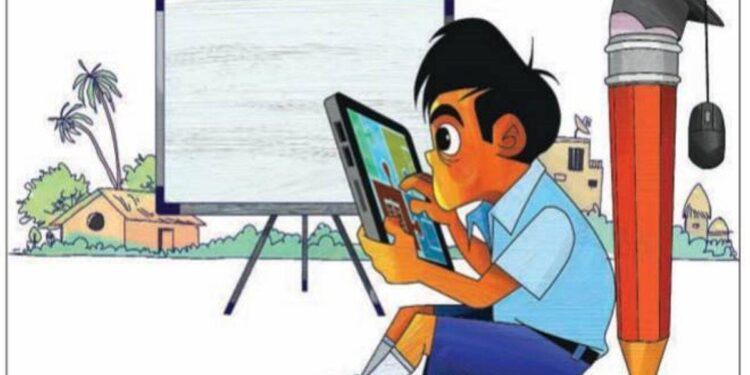 Children should be seated with their neck and back straight, elbows relaxed, with adequate support.
Children should be seated with their neck and back straight, elbows relaxed, with adequate support.By Dr Reena Valecha
Twelve-year-old Lavanya is now perfectly at home with virtual learning. She’s going into class seven, her second year of virtual school amid the COVID-19 pandemic. Where last year was spent getting to grips with learning in an online classroom, this year she, her classmates, her teachers, and even her parents are far more at ease learning and interacting off a computer screen.
The first year was all about adapting to a new way of life and learning for parents, teachers, and students across the country amid uncertainties about the effectiveness of virtual learning.
This year, with those concerns laid to rest and with online learning increasingly looking like it, is here to stay amid the still-raging pandemic, the focus is shifting to the ergonomics of the ‘study from home’ classroom mode.
As classrooms moved to the virtual world last year, it soon became apparent that students were logging in sitting on the floor, on the sofa, or even on their beds. Apart from maybe a study table, used primarily in pre-pandemic days for a short duration, post-school studies, or homework, households naturally didn’t have “classroom” infrastructure.
But students are now spending as many as six hours attending classes at home on a laptop – and sometimes on handheld mobile devices with much smaller screens. As a result, 41% of children complained of eye strain issues.
Health experts warn the resultant poor posture, lack of physical activity and prolonged screen time could lead to severe long-term consequences putting children at risk of developing spinal problems and musculoskeletal disorders.
Poor posture is bad for everyone. But it can take an exacting toll on children as their bones aren’t yet properly fused. This puts them at increased risk of incorrect spinal alignment, causing the spine to form an ’S’ or ‘C’ shape in a condition known as Scoliosis, which in turn can lead to slouching or Kyphosis.
As a result, parents must ensure their children are seated correctly, have plenty of breaks, and are engaged in physical activity that keeps them moving from time to time and while homes will never fully mimic classrooms or the school environment, there are plenty of simple ways parents can do this.
To begin with, parents need to explain the 90-90-90 rule to children. The back and the thighs should form a 90-degree angle while sitting; knees should also be at a 90-degree angle, and the feet and the ankle should be at a 90-degree angle as well. Parents should invest in an ergonomic desk, an adjustable chair of the right size, laptop stands that can be adjusted to make sure they are at the right height, a separate keyboard, and a mouse. At the same time, the study area should be properly illuminated to reduce the strain on the children’s eyes.
Children should be seated with their neck and back straight, elbows relaxed, with adequate support. Feet should also firmly rest on the ground or on a footrest to avoid awkward knee and foot postures.

If a child has to sit on a sofa or the floor or the bed, parents should again ensure they adopt the right posture and use a portable table that will ensure their laptop screens are at eye level so they don’t have to look down.
Parents should create a task-appropriate environment that is equally sensory soothing for children. Ensure the room is properly ventilated, lighting is adequate, and non-distracting during learning time. If possible, leave the windows & doors open, and add some indoor plants to their study area for some freshness.
Another key to mitigating any long-term consequences of the virtual classroom is the scheduling of activity breaks. In school, children are active in between classes, or in their lunch breaks, or even simply walking up the stairs to their classrooms at the start of the day. Parents need to make sure their children remain just as active in between lessons. Parents need to carefully include micro-breaks in the children’s routine which do not affect their concentration & school routine and equally ensure adequate physical movement. It can be taking a short walk or motor activities like coloring or physical writing with a pen or pencil so the child doesn’t miss out on developing those muscles or those skills in a digital world.
Equally, after sessions, parents can engage their children in fun physical activities to build or maintain their aerobic fitness. Before the pandemic, children would go out, cycle, play cricket or football, or play playground games with their friends. That’s not possible amid the pandemic, so parents need to be equally creative to get children involved in fun physical activities like animal movements, treasure hunt games where children involve core exercise postures while playing.
Being indoors and forced to live our lives virtually is not ideal for anyone, not least our children. But there are steps we can take to mitigate the consequences of being locked down. They may not replicate the physical and ergonomic features of a full-fledged school environment. But they will go a long way towards ensuring the health and wellbeing of our children.
(The author is Principal Ergonomist – Workplace & Ergonomics Research Cell , Godrej Interio. Views expressed are personal.)
Get live Stock Prices from BSE, NSE, US Market and latest NAV, portfolio of Mutual Funds, Check out latest IPO News, Best Performing IPOs, calculate your tax by Income Tax Calculator, know market’s Top Gainers, Top Losers & Best Equity Funds. Like us on Facebook and follow us on Twitter.
![]() Financial Express is now on Telegram. Click here to join our channel and stay updated with the latest Biz news and updates.
Financial Express is now on Telegram. Click here to join our channel and stay updated with the latest Biz news and updates.














